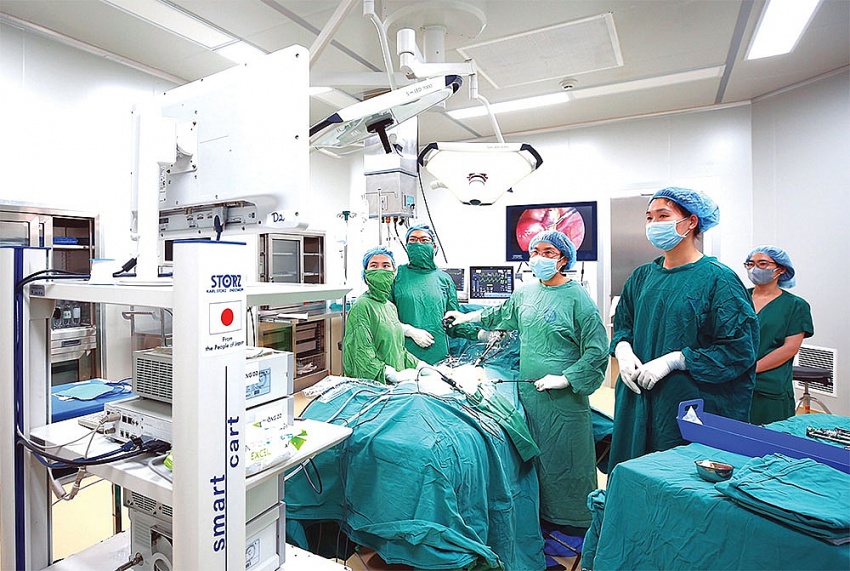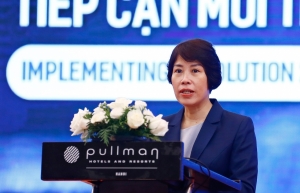Legal reform can be key to pharma innovation bonanza
 |
| Like others, Vietnam is looking at how to transform healthcare after the turbulence of the last few years, Photo: Le Toan |
At last week’s VIR’s health conference on realising Resolution No.29-NQ/TW, fresh approaches in investment attraction in the pharma industry were a hot topic of discussion with a number of barriers and regional lessons analysed by policymakers, businesses, and experts.
Phan Duc Hieu, standing member of the National Assembly Economic Committee, said that international competition is huge, so Vietnam’s policies need to be more competitive to help promote development.
“We often mention financial support policies and financial incentives. Investment in pharmaceuticals is huge, so finance is not a problem for them. What investors need is safety, stability, and a predictable and operating environment to help them feel secure,” he said.
Prof. Nguyen Hai Nam, rector of Hanoi University of Pharmacy, added that attracting investment in pharma is still tough because it is a risky field that requires high qualifications.
“We have many policies, but not enough. For example, from project formulation to investment, sometimes it takes five years. Foreign-invested enterprises want a more open mechanism. It is yet to have a preferential loan scheme for investment in high technology in the pharmaceutical field,” Nam said.
Participants at the conference agreed that opportunities are opening up for Vietnam to allure investment from the innovative pharmaceutical industry thanks to its consecutive economic growth and development.
According to the Pharma Group, which represents foreign research-based pharma manufacturers and has 22 members from the US, Europe, and Japan, the sustainable development of a country will need to rely on the foundation of science-technology and innovation. Of all industries, the innovative pharma industry has the highest investment in innovation. Over the past 10 years, it saw funding of over $1 trillion in research and development (R&D), and Pharma Group members are required to invest at least 10 per cent of global sales in R&D.
“These investments are not limited to healthcare, but have spillover effects to other industries and bring enormous economic and social benefits through strengthening innovation capacity – this is the key value proposition of the innovative pharmaceutical sector as a key factor enabling countries for sustainable development in the future,” said Emin Turan, chairman of Pharma Group.
Learning from others
According to Le Trong Minh, editor-in-chief of VIR, attracting investment in the pharma-healthcare industry is not only meaningful in terms of capital to improve capacity and develop the healthcare industry, but also has the effect of strengthening the connection and pervasiveness as in the spirit of Resolution 29.
“Attracting investment into this industry is becoming a race on both a regional and global scale, in which every country wants to take a bigger share. Just looking at the trillions of US dollars that biopharmaceutical companies will invest in R&D this decade can also partly explain this,” he said.
Resolution 29 stated that industrialisation and modernisation of the country is based mainly on the development of industry and services on the basis of sci-tech and innovation; and to develop biologicals into a spearhead industry.
However, Vietnam is facing challenges due to stiffening competition from regional players, and Turan of the Pharma Group cited Singapore as an example. “Singapore has successfully positioned itself as a regional hub for pharma manufacturing, research, and innovation over the past two decades,” he said. “This achievement can largely be attributed to the implementation of a biomedical sciences initiative and prioritisation of the sector at the national policy level since the turn of the century.”
Dr. Trinh Van Lau, chairman of the Vietnam Pharmaceutical Companies Association, added, “One of the countries we need to learn from is South Korea, which has so far made many breakthroughs in biotechnology and pharmacy. They have developed many research centres for biopharmaceutical applications such as Celtrio, Samsung Bio, Hanmi Bio Lotte Bio, and Dong A Bio.”
Wider scope required
The leaders at the event recommended rapid changes in regulations to tap into the investment trend in the innovative pharmaceutical industry.
“We expect the action plan for Resolution 29 to prioritise policy reform, establish tangible goals to expedite patient access to new medicines, and integrate innovative healthcare financing mechanisms that harmonise benefits of stakeholders,” explained Turan.
“Sector development should be based on research and innovation; and a roadmap should be in place to foster a conducive ecosystem based on competition, innovation, and comprehensive and broad integration. This will ultimately enhance the competitiveness of Vietnam’s pharmaceutical industry both regionally and globally.”
Vietnam’s pharma industry has high potential growth. According to IQVIA, the global pharmaceutical industry could be worth $1.7 trillion (at manufacturer’s prices) by 2025. Fitch Solutions predicted that domestic pharmaceutical sales in Vietnam will reach $7.16 billion by the end of 2023 and $9.15 billion in 2026.
To attract investment in the industry, the Law on Pharmacy 2016 regulates state policies on investment incentives for production of drugs, medicinal ingredients, vaccines, biological products, and incentives for scientific research on preparation technology and biotechnology for the production of new drugs.
However, the current policies on procurement, encouragement, and support are focused on the production of drugs in general, leading to production facilities mainly focusing on investing in the production of common generic drugs, and not focusing on research and production of high-tech or specialised equivalents.
Worse still, the price management policy and orientation on the use of generic products also limit the transfer of technology to produce innovative and brand-name drugs into Vietnam. Do Van Su, deputy director of the Foreign Investment Agency under the Ministry of Planning and Investment, elaborated that in the pharmaceutical industry, the changes in manufacturing are slower than in other industries.
“Previously, the industry was controlled by the state, then through the equitisation process, private enterprises participated. However, equitised groups still have people with traditional mindsets so they cannot hasten transformation,” he noted.
| Phan Duc Hieu - Standing member National Assembly Economic Committee
The Ministry of Industry and Trade is currently developing the law on the advancement of spearhead industries and breakthrough technologies. This move, coupled with the existing pharmaceutical law, provides a legal framework that can help shape the future of the country’s industrial landscape. However, it is crucial that the policies introduced align with the needs and wants of investors, rather than solely reflecting the government’s objectives. Many foreign investors prioritise aspects such as protection and risk management before considering tax incentives. Therefore, the government needs to ensure that these concerns are addressed in its legislative efforts. I see that the competition within the region is fierce. While Vietnam has its advantages, other countries in the region have their own unique strengths as well. As such, the country needs to strategically position itself to compete more effectively. This will require a different and more potent approach to change. Moreover, stronger multi-stakeholder collaboration is also needed. The government, private sector, and academic institutions must work together to create an environment that fosters growth and innovation. This opportunity should also be extended to Vietnamese enterprises, allowing them to play a more significant role in the country’s industrial development. Nguyen Thi Bich Ngoc - Deputy Minister of Planning and Investment
In recent times, the Ministry of Planning and Investment (MPI) has worked with many large-scale pharma groups in Vietnam, and see that they are interested in developing a specialised industrial park for the pharmaceutical sector. The MPI evaluates that it is a good idea because if we can develop specialised industrial clusters and parks for this industry, they will be a foundation to lure more capital inflow, creating momentum to take Vietnam to become a hub of the region in producing pharmaceuticals. Based on this spirit, the MPI is looking forward to receiving opinions about the feasibility of these projects, as well as proposals relating to incentive mechanisms and policies. Besides that, Vietnam’s pharma and healthcare sector has much potential for development, however, it has yet to match the potential as well as the government’s expectations. Thus, the MPI expects to listen to opinions from experts, investors, and manufacturers in order for the pharma sector to have better conditions to diversify the portfolio of pharmaceutical products, receive international technology, and lure in more investment. Nguyen Manh Cuong - Deputy director Institute of Natural Products Chemistry Vietnam Academy of Science and Technology
The workforce is the most important resource that determines the success of innovation. In 2022, Vietnam ranked 48th in the global innovation index, and 60th in terms of training and full-time scientists. Currently, Vietnam has two universities ranked at the top of the list for training human resources for innovation. This number is very modest compared to the rest of the world. The nation only invested 0.5 per cent of its total budget expenditure on technology R&D in 2019. By 2025, the total national budget for science and technology investment will increase to 0.8-1.2 per cent. By 2030, the number will reach 1.2-1.5 per cent. It is clear that our investment is too low in this field. We do not have enough manpower and financial resources. The government plays an essential role in promoting innovation. The state needs to come up with a comprehensive and synchronous policy with specific actions and criteria in a short time. Vietnam could set up an innovation-related government agency to guide specific policymaking. In particular, there needs to be a strategy to invest in life sciences and biotech to create new drugs, especially drugs using local medicine materials. Ingo Brandenburg - Managing director Bayer Vietnam
Vietnam’s pharmaceutical market has significant potential. With a population of around 100 million, of which, people aged from 65 and over account for 11.9 per cent, the need for patient access to medicines is anticipated to grow at a stronger pace. Considering the rising healthcare burden related to an ageing population, investing in innovative medicines and technologies has become more important than ever. Innovative medicines can put healthcare systems on a more sustainable path by reducing inefficiencies and costs, such as reducing hospitalisations, physician visits, or other expensive procedures and surgeries, as well as supporting the caregivers on the better treatment outcomes of patients who rely on them. Additionally, further adoption of private supplemental health insurance can help ease the government’s budget constraints in the short- and mid-term. As an innovative pharmaceutical company operating in Vietnam, Bayer has taken many meaningful steps to help accelerate industry development and bridge the gap through expanded patient access support and collaboration initiatives. Collaboration of multidisciplinary stakeholders from public and private sectors is needed in improving access and adoption of innovative medicines. At the same time, the government and healthcare systems play a crucial role in developing policies that can keep pace with innovation, enabling speedier approvals and timely access and adoption of innovative therapies and technologies. By working together, different stakeholders can jointly identify opportunities and remove barriers through innovative approaches to achieve the best outcomes for patients and society. Bui Duc Hanh - Founder and CEO chothuoctot.vn
The challenges faced by the local pharmaceutical industry here in Vietnam include the ability to access loans, impediments with relevant legal systems, and high transportation costs. To remove difficulties and create conditions for pharmaceutical businesses, the state should encourage and give incentives to projects on digital transformation for the entire industry. The projects will help bolster competitiveness of local pharmaceutical firms as well as help reduce drug costs for users as currently, the cost of using drugs for patients is very high over the production costs. Our desire is that leveraging current technology platforms, our business in companion with our partners helps create an ecosystem in the healthcare industry where patients can easily access the system, and receive more dedicated care at the best cost. Luke Treloar - Head of Strategy KPMG Vietnam
In a recent KPMG report, we looked at what could be the social, economic, and industrial value of a productive, innovative life sciences sector in Vietnam. We looked at how other countries have developed around the world, take comparable models, and then make policy recommendations for what it could do to reach those goals. We looked at things like intellectual property rights development, localisation of technology, and encouragement of technology localisation through incentives to tax incentives, some countries give direct cash incentives for localisation of technology. Furthermore, we provide three case studies of exciting markets like Ireland, South Korea, and Singapore of how those three markets became life sciences hubs. Each of those markets uses different policies. South Korea uses governments and academic partnerships to form ecosystems and develop their industry, Singapore used infrastructure, developing perfect, cheap, and widely available infrastructure for the life sciences sector. And Ireland uses tax reductions to draw in intellectual properties. Vietnam most certainly can become a life sciences hub for Southeast Asia. We recently conducted a lot of research looking into how it could do that, and where it should focus. But Vietnam is not alone and neighbours other countries that are highly competitive and motivated to become a life science hub for Southeast Asia. We have identified three key areas that Vietnam should explore in more detail. The first one is the localisation of manufacturing of life sciences, the second is digital health, and the third is the localisation of research and development (R&D) into Vietnam started in clinical trials. There are numerous opportunities in Vietnam to localise clinical trials. The global pharmaceutical industry has spent $1 trillion on R&D for their industry. If just a fraction of that value were localised to Vietnam, it could have retable benefits to the domestic economy. Furthermore, the global pharmaceutical industry spends $1 trillion on developing intellectual property. If a company can’t protect its intellectual property, it’s not going to make an investment. Vietnam needs to put intellectual property at the core of its industry; otherwise, the industry won’t develop. As we’ve seen in other countries like South Korea or Singapore that once had challenges with their intellectual property, domestic companies also develop intellectual property becomes a much more imperative matter. |
 | Vietnam at the crossroads: The race to secure pharma investment The first panel session, themed Vietnam at the crossroads: The race to secure pharma investment, from VIR's event Realising Resolution 29: New Approaches for Pharma-Healthcare Development on July 20 drew significant attention. The discussion centred around the quality of labour in the pharmaceutical sector and the strategic decisions that Vietnam faces in its pursuit to attract investment in this vital industry. |
 | More than 200 participants join VIR's conference on pharma and medical sector Over 200 attendees gathered at the conference to focus discussions on the importance of Resolution No.29-NQ/TW to the future sustainable development of Vietnam’s health system, learning lessons from other nations, identifying where there is room for improvement, and promoting public-private collaborations. |
 | MPI calls on investors to make suggestions in pharma sector The Ministry of Planning and Investment has called on investors and manufacturers to contribute opinions and proposals to attract more investment capital and receive technology transfer to promote the development of the pharmaceutical sector of Vietnam. |
 | Powering innovation for sustainable pharma-healthcare development Experts highlighted the importance of powering innovation for sustainable pharma-healthcare development at the second panel discussion at a VIR conference on Thursday July 20. |
 | Vietnam's pharma sector shows potential Prof. Nguyen Hai Nam, rector of the Hanoi University of Pharmacy, recently asserted the potential strength of human resources in Vietnam's pharmaceutical sector, suggesting it could be the underpinning element for attracting global investment. |
 | More effort needed to increase pharma readiness Amid existing challenges and new investment approaches towards innovation and science and technology, the pharma-healthcare sector is working to tap into these trends, while developing and enhancing regulations. |
What the stars mean:
★ Poor ★ ★ Promising ★★★ Good ★★★★ Very good ★★★★★ Exceptional
Themes: Healthcare Platform
- Takeda Vietnam awarded for ongoing support of Vietnam’s sustainability efforts
- Self-care signals shift towards sustainable healthcare
- DKSH to acquire Vietnamese healthcare distributor Biomedic
- Two national hospitals expand capacity with new facilities
- Vietnam moves to enhance disease prevention, equity, and sustainability
Related Contents
Latest News
More News
- Takeda Vietnam awarded for ongoing support of Vietnam’s sustainability efforts (December 31, 2025 | 21:00)
- Vietjet chairwoman awarded Labour Hero title (December 29, 2025 | 13:06)
- How to unlock ESG value through green innovation (December 29, 2025 | 10:03)
- AI reshapes media and advertising industry (December 29, 2025 | 08:33)
- FPT and GELEX sign deal to develop blockchain tech for global markets (December 29, 2025 | 08:29)
- Vietnam’s GDP forecast to grow by 9 per cent in 2026 (December 29, 2025 | 08:29)
- Women entrepreneurs are key to Vietnam’s economic growth (December 29, 2025 | 08:00)
- Vietnam's top 500 value-creating enterprises announced (December 27, 2025 | 08:00)
- The PAN Group shaping a better future with ESG strategy (December 26, 2025 | 09:00)
- Masan Consumer officially lists on HSX, marking the next phase of value creation (December 25, 2025 | 13:20)







 Tag:
Tag:





















 Mobile Version
Mobile Version